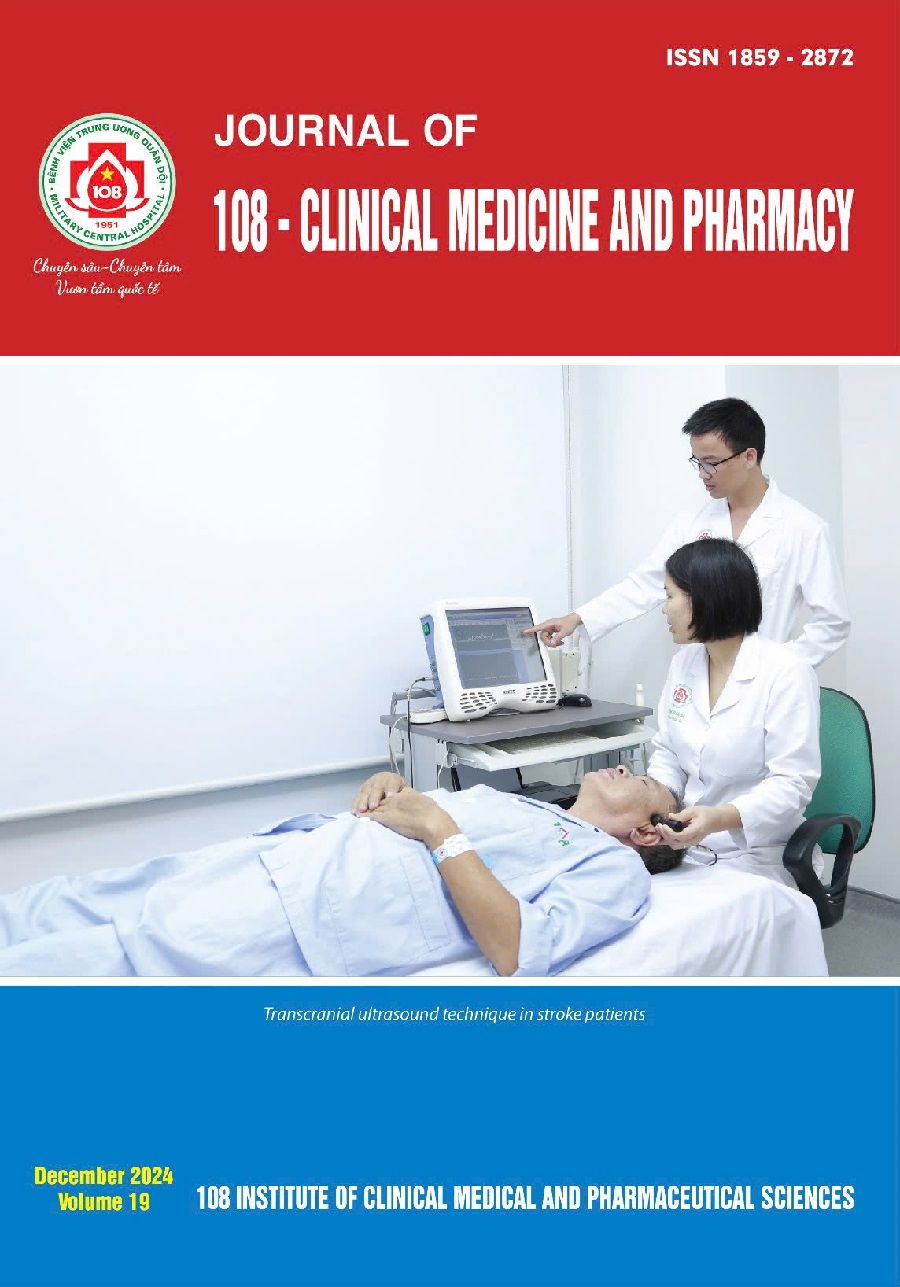Outcomes of episiotomy and perineorrhaphy in vaginal delivery at the National Hospital of Obstetrics and Gynecology
Main Article Content
Keywords
Tóm tắt
Objective: To evaluate the outcomes of episiotomy and perineal suturing in vaginal delivery at the Obstetrics and Gynecology Hospital. Subject and method: This is a prospective descriptive study involving all vaginal delivery patients who underwent episiotomy and perineal suturing at the National Hospital of Obstetrics and Gynecology from November 1, 2023 to December 31, 2023. Result: A total of 384 women were included in the study, with an average age of 28.32 ± 5.12 years (the youngest being 15 years and the oldest 42 years. The age under 35 years accounted for the majority of 88.3%. The proportion of primiparous was 55.73%, while 44.27% were multiparous. The incidence of mothers with diabetes was the highest, accounting for 13.5% of the total study population. The indication for perineal incision was predominantly maternal, accounting for 88.52%. There were 15 cases with a third-degree perineal tear, accounting for 3.90%. Of these, the rate of injury after forceps delivery was 100%. There were 4 cases of hematoma and 1 case of infection post-episiotomy. The rate of third-degree perineal injury when fetal weight was >3500g and BPD > 95mm were 31.2% and 73%, respectively. Conclusion: Episiotomy and perineorrhaphy remain common procedures in vaginal deliveries in Vietnam. Most cases do not result in complications, and the perineum typically tears only to a physiological degree, specifically to degree II, with a low rate of complex tearing. Our study indicates that forceps delivery increases the risk of more severe perineal injuries. Moreover, third-degree tears are associated with infants weighing over 3500grams and BPD more than 95mm.
Article Details
Các tài liệu tham khảo
2. Woretaw E, Teshome M, Alene M (2021) Episiotomy practice and associated factors among mothers who gave birth at public health facilities in Metema district, northwest Ethiopia. Reprod Health 18(1): 142. doi: 10.1186/s12978-021-01194-9.
3. Muhleman MA, Aly I, Walters A, Topale N, Tubbs RS, Loukas M (2017) To cut or not to cut, that is the question: A review of the anatomy, the technique, risks, and benefits of an episiotomy. Clin Anat N Y N. 30(3): 362-372. doi: 10.1002/ca.22836.
4. Goldberg J, Hyslop T, Tolosa JE, Sultana C (2003) Racial differences in severe perineal lacerations after vaginal delivery. Am J Obstet Gynecol 188(4):1063-1067. doi:10.1067/mob.2003.251.
5. Clesse C, Cottenet J, Lighezzolo-Alnot J et al (2020) Episiotomy practices in France: Epidemiology and risk factors in non-operative vaginal deliveries. Sci Rep 10(1): 20208. doi:10.1038/s41598-020-70881-7.
6. Nguyễn Tuấn Việt (2015) Nhận xét tình hình cắt khâu tầng sinh môn sau đẻ tại Bệnh viện Phụ sản Trung ương năm 2015. Đại học Y Hà Nội.
7. Lam KW, Wong HS, Pun TC (2006) The practice of episiotomy in public hospitals in Hong Kong. Hong Kong Med J 12(2):94-98.
8. Graham ID, Carroli G, Davies C, Medves JM (2005) Episiotomy rates around the world: An update. Birth 32(3): 219-223. doi:10.1111/j.0730-7659.2005.00373.x.
9. Balamurugan V, Joseph K, Kurian R, Joseph T (2020) “How short is too short“ - Comparison Of Maternal Height With Delivery Outcome. Br J Med Health Sci BJMHS 2(7). https://www.jmhsci.org/wp-content/uploads/2020/07/BJMHS450116.pdf.
10. State of Maternity Care in the U.S. (2023) The Leapfrog Group 2023 Report on Trends in C-Sections, Early Elective Deliveries, and Episiotomies | Leapfrog. Accessed November 4, 2024. https://www.leapfroggroup.org/state-maternity-care-us-leapfrog-group-2023-report-trends-c-sections-early-elective-deliveries-and.
11. Chuilon AL, Le Ray C, Prunet C, Blondel B (2016) Episiotomy in France in 2010: Variations according to obstetrical context and place of birth. J Gynecol Obstet Biol Reprod (Paris) 45(7): 691-700. doi:10.1016/j.jgyn.2015.10.005.
12. Shmueli A, Gabbay Benziv R, Hiersch L et al (2017) Episiotomy - risk factors and outcomes. J Matern Fetal Neonatal Med 30(3): 251-256. doi:10.3109/14767058.2016.1169527.
13. Meyer R, Levin G (2022) Risk factors for obstetric anal sphincter injury among adolescents. Eur J Obstet Gynecol Reprod Biol 270:151-155. doi:10.1016/j.ejogrb.2022.01.009.
14. Maher GM, O’Byrne LJ, McKernan J et al (2023) Predicting perineal trauma during childbirth using data from a general obstetric population. HRB Open Res 5:79. doi:10.12688/hrbopenres.13656.2.
15. Carroli G, Mignini L (2009) Episiotomy for vaginal birth. Cochrane Database Syst Rev 1): CD000081. doi:10.1002/14651858.CD000081.pub2.
16. Laganà AS, Terzic M, Dotlic J et al (2015) The role of episiotomy in prevention of genital lacerations during vaginal deliveries results from two European centers. Ginekol Pol 86(3): 168-175. doi: 10.17772/gp/2058.
17. Zhu L, Yang J, Wang J et al (2015) Restrictive use of episiotomy for low forceps delivery. Zhonghua Yi Xue Za Zhi 95(17): 1328-1330.
18. Chigbu B, Onwere S, Aluka C, Kamanu C, Adibe E (2008) Factors influencing the use of episiotomy during vaginal delivery in South Eastern Nigeria. East Afr Med J 85(5): 240-243. doi:10.4314/eamj.v85i5.9618.
 ISSN: 1859 - 2872
ISSN: 1859 - 2872
